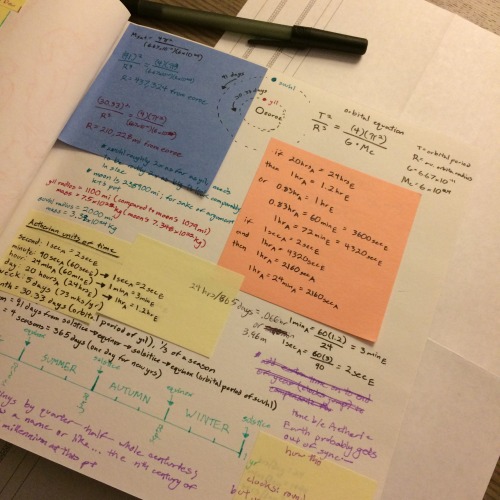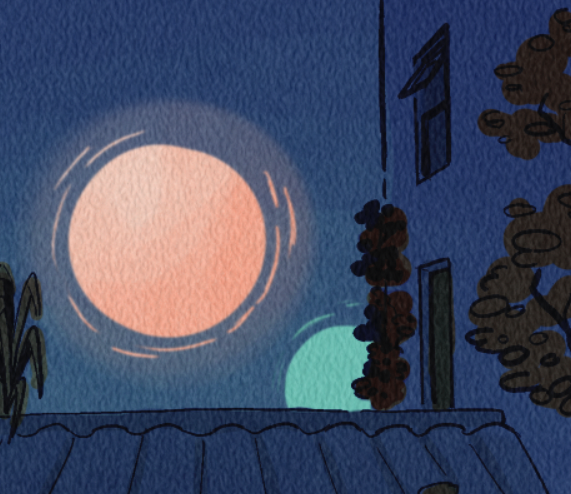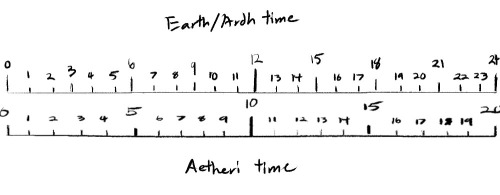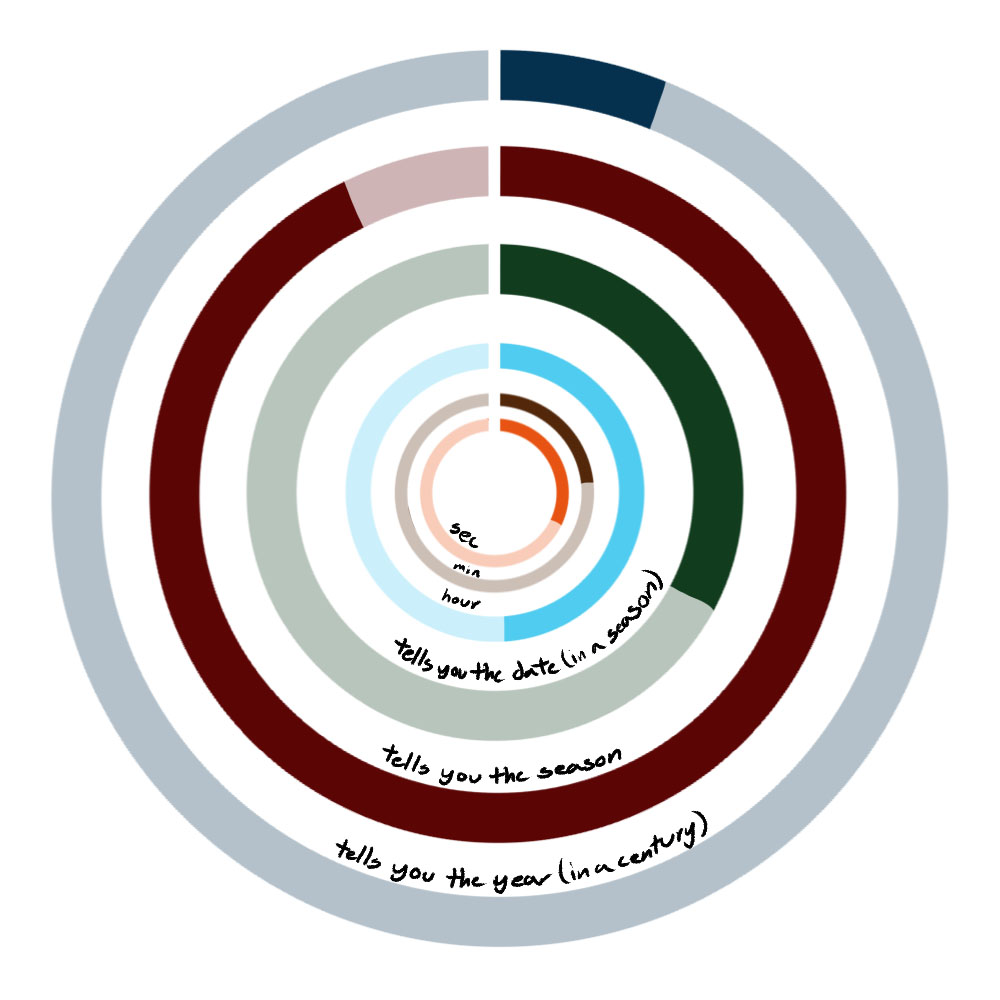How time is measured in Aetheri
backI have avoided showing clocks and calendars thus far (as of 2017) in Aetheri because I didn’t want to do the math to come up with a fictional time system that both worked and didn’t make story events IMMENSELY complicated to coordinate. What I came up with works, but you’ll have to suspend your disbelief a little, because it’s oddly convenient (by design) for a supposedly alien system of time.
There’s a larger question at hand here than just the mechanics of how spirits measure time--how does a species with a lifespan of around a thousand earth years measure time? How do they perceive its passage?
It’s probably obvious by now that spirits don’t seem to move at any slower of a pace than humans; they aren’t like ents, for example. The spirit-vs-human perception of time is actually a pretty lively albeit tiny field of study in Escalus. The way spirits treat time seems to mirror the way that humans do, just on a much longer time scale, which some people seem to think says something about the plasticity of the brain, its structure, and how it compartmentalizes things.
There’s two rather different ways on the whole that spirits seem to perceive time, and it all seems to depend on what happens to them. Vlad and Numair are singular examples of each, in fact, and they’re even around the same age. Not a hell of a lot has happened to Numair in his 300+ years alive; he’s spent most of that time in Escalus, in the Palace, and so to him life seems to blur together--it doesn’t seem particularly long, just uniform. This is pretty normal for spirits. They live in a flat land under a wide sky. Time just smudges together, rather like a Sunday afternoon where you’ve done nothing all day and then suddenly it’s night. By this logic it's easier to understand the Aetherian preoccupation with things that happened 7000 years ago, and their unpleasant surprise at how different Earth became in the time between the start of Aetherian isolation in their postwar and their reconnection with other worlds: sure, it's been a long time, but not seemingly THAT long.
On the other hand, Vlad’s had a lot happen to him; he’s seen and done a lot, and has been a lot of different people. Spirits like this seem to actually shed their past lives somewhat. It’s a little like you thinking of an event that happened to you a decade ago, and describing it as like another lifetime--but in spirits, this seems to be a fully-realized psychological experience. It’s a dissociation from past events, good or bad, that spirits will often describe as like a death and rebirth. It doesn’t come in an instant--it almost always corresponds to major life changes--but what’s sort of weird about it is how total it is. Spirits will often refer to this sort of jokingly as their ‘past lives,’ but, only sort of jokingly.
The prevailing view on this is that it’s merely a psychological coping mechanism, but some have argued for a physical component as well. Spirit brains are not significantly different-looking (it seems) than human brains, although they keep themselves up much better over the years by necessity. It hasn't been well-studied, but some suspect that the brain actually does fully replace itself multiple times over the course of a spirit's lifetime in the same way that your skin cells die off and reproduce so rapidly that you essentially have new skin every year or so (estimated, affected by various factors, etc.) In humans, brain cells do replenish, but at a very slow rate; in spirits that rate could still be slow, but with a long enough lifetime, you would still see the brain fully 'replaced.'

So that's the 'soft' version of measuring time--now for the math.
I worked this all out mostly on paper as you can see. The two conceits I worked with here were A) use Suuhl and Yil somewhere in making Aetherian timekeeping, and B) it needed to match up to time on Ardh, or at least not drift so far that I’d have to do bonkers calculations to figure out corresponding times in both universes.
You may remember Suuhl and Yil as being Aetheri’s two moons.
Suuhl is the blue one (so called because it’s a much further away, more ghostly object, and ‘suuhl’ is the Aetherian word for ghost) and Yil is the red one. Suuhl orbits Eoroe (which is the planet’s name--Aetheri is just the country) every 91 days, and Yil orbits every 30.33 days. Eoroe is slightly more massive than Earth but rotates at almost exactly the same speed--therefore, an Aetherian day is equal in length to an Earth day, although the way it’s measured is different.
(Ardh, which is where the Symphony Archipelago is, is essentially indistinguishable from Earth as a celestial object except for its topography. Just to make things less complicated.)

Time is measured in Aetheri by the following:
- dheidt (1 dheid = 2 seconds)
- rymmat (1 rymma = 90 dheidt = 3 minutes)
- huurat (1 huura = 24 rymma = 1.2 hours)
- leit (1 lei = 20 huurat = 1 earth day/24 hours)
- vaact (1 vaac = 5 leit = 5 earth days) - this is an Aetherian ‘week’
- yilruumt (1 yilruum = 30.33 leit or 30.33 days) - this is one ‘month’ or ‘moonth,’ namely, this is the orbital period of Yil--the ‘Yil-round’
- suuhlruumt (1 suuhlruum = 91 leit or 91 days) - this is a ‘season’, which stretches from a soltice to an equinox or vice-versa; it’s also the orbital period of Suuhl or the ‘Suuhl-round’
- ieirt (1 ieir = 365 leit/days = 4 suuhlruumt + 1 extra day) - this is a year, obviously, the time it takes Eoroe to go around its sun.
If you would like to see very roughly how Aetherian measures of time compare to the Gregorian calendar, I have made a goofy spreadsheet for you to check out, which you can see here.
Some of these measurements are a little odd, particularly the yilruum, which is essentially a month. Aetherians will use a yillruum only in non-specific instances, since it includes a third of a day--you’d use it to talk about a section of a season or suuhlruum. There are twelve yilruumt in a year, three per season, each named for a dominant constellation in the sky during their time. (Essentially this is the Aetherian zodiac, and yes, they do have astrology based on it.) The names of the yilruumt are included on the linked spreadsheet; they’re just named after things like animals, tools, and so on.
When you talk about a date in Aetherian, generally you describe it as being the nth day of the season in the nth year pre- or post-war. Hawk was born on April 4, 1986; Aetherians would describe this as the 13th day of Summer in year 6989 postwar. (There’s a caveat to this, I’ll get to it.) Dhuv, the Aetherian ‘month’ Hawk was born in, roughly corresponds to March 23-April 22, and wouldn’t be used to describe his birth except in an astrological context.
You’ll notice there’s a day 0 on the Aetherian calendar--this is their winter solstice and their new year. It’s considered a ‘nothing’ day, there to balance out the calendar, more or less.
There’s no need for a leap day in the Aetherian calendar--it’s balanced out perfectly, there is no time lost. However, this does mean that there’s some drift between it and the Gregorian calendar, to the tune of about 59 seconds every day, until the next leap year comes round and puts it all back on track again. I’ll be straight with you: I’m not smart enough to figure out how to calculate for that. The consequence in-universe is that you just need to have an Earth clock and an Aetherian clock around at all times if you want to know what time it is in the other place; the consequence IRL is that I don’t actually know if Hawk’s birthdate matches up to the 13th day of Summer or the 14th, but I suppose it doesn’t matter that much. Math was never my strong suit, there's a reason I've avoided this topic too much in-comic.
That said, trying to figure out what time it is in the Archipelago vs Aetheri is a big pain in the ass. I made a rough scale, but again, it doesn’t account for time drift caused by leap days and of course time zones:

Aetheri uses what’s essentially military time; as above, 1 Aetherian hour (hurra) is 1.2 Earth hours, so there’s some drift over the course of the day between the two time scales.

On the upside, Aetherian clocks are generally pretty easy to read, although they’re often unmarked. Rather than having numbers on them, they usually work by filling bars or circles, and you generally just get a feel for what time it is. Sort of like reading an analog clock, but less exact. They do usually include the year in the outermost ring, as based on a 100-year century. Beyond that, you’re on your own; you should probably know what millennium it is.
Aetherians essentially have two time systems: the exact down-to-the-dheid version that's used for record keeping, magical workings, and government activities, and the more vibes-based time scale that everyday people use. Things are slower in Aetheri; not every instant always needs to be accounted for. Even work shifts are a little loose--no one cares if you start exactly at 0800, for example, as long as you're there at about the same time every day.
There are other implications to perceiving time differently that I'm not going to go into here, but they're interesting (to me) nonetheless. For example, does a different measurement of time affect the way Aetherians make music? Or how they perceive other cultures' music? I don't know!